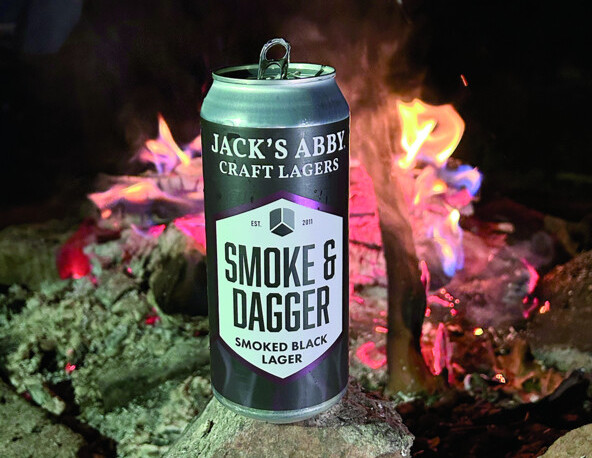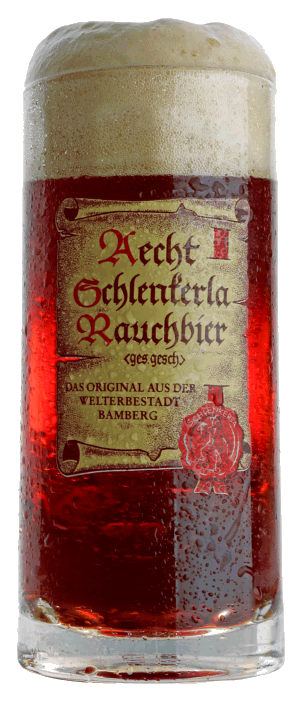
Polarizing. That’s the term beer marketers and retailers use when describing consumer response to smoked beer, the traditional German beer style that’s been revitalized by some craft brewers in recent years. “Consumers of smoked beers are part of a wildly passionate niche,” says Rob Day, vice president of marketing at Framingham, Massachusetts-based Jack’s Abby Brewing, producer of the year-round Smoke & Dagger smoked black lager. But other consumers—who may be sensitive to the style’s characteristic smoke flavor—aren’t fans.
Smoked beers are U.S. brewers’ interpretation of rauchbier, the centuries-old beer style that resulted from the common practice of drying malted grain by sun or open wood flame, imparting a rich, smoky flavor to the beer. The creation of the drum kiln in the early 1800s allowed maltsters to better control the drying process and before long, the smoke flavor in beer almost entirely disappeared from beers produced around the world.
A few European breweries, however, have continued to brew rauchbiers. Germany’s Brauerei Heller-Trum is perhaps the most notable, almost exclusively producing rauchbiers. Aecht Schlenkerla maerzen rauchbier, the brewery’s flagship, has been available in the U.S. for nearly 30 years, according to Matthias Neidhart, president of importer B. United International, with other styles including doppelbock, weizen, and helles rounding out the portfolio. This year, the limited release “Weichsel” Cherrywood Smoke edition, featuring barley malt smoked over sour cherry wood, was released for the first time.

The Schlenkerla brands have served as an inspiration for U.S.- produced smoked beers, part of an overall revitalization in classic European beer styles by craft breweries. Jack’s Abby has produced Smoke & Dagger since 2015; it’s available along the East Coast in cans and on draft. The brewery also releases Fire in the Ham smoked lager every summer, available only at its beer hall. Day says that while Smoke & Dagger is relatively low on the smokiness scale, Fire in the Ham is more intense, carrying the aroma of a campfire. “It goes phenomenally with ham,” the brewer says, a characteristic that played into the brew’s branding.
“Consumers who love smoked beers really love them,” Day says. He adds that he’s beginning to see a crossover of consumers of peated Scotches and mezcals to smoked beers, pointing to the peat-like characteristic of the brews. Neidhart agrees that smoked beer drinkers are loyal, and “not at all like the typical promiscuous craft beer consumer.” The importer concedes, however, that “consumers may not fall in love with the style the first time they try it. In fact, they may be shocked by the uniqueness of the product.” But he adds that the story behind the style and its food-pairing attributes often wins them over.
Marc Gelsomino, beer and wine manager at Beverage Warehouse in Winooski, Vermont, says that while smoked and rauchbiers are a “pretty narrow niche” at his store, “awareness is high among those who like them.” The brews can also appeal to “experimental” beer consumers, the retailer says, as “it’s an easy style to educate customers about,” particularly when it comes to food pairings. Gelsomino recommends Schlenkerla maerzen as a companion to foods like barbeque, and says it can be used in chili. Beverage Warehouse carries Schlenkerla maerzen ($15 a 4-pack of 500-ml. cans) year-round, along with seasonal smoked beers from local brewers “whenever we can get them,” he says.
At Beer Boutique bottle shop in Brooklyn, New York, owner Vitalik Sherman also advises customers on pairing smoked brews with food. A former chef, Sherman recommends barbecued sausage and red meats to complement the likes of Kings County Brewers Collective’s Helles Kitchen smoked helles lager ($6 a 16-ounce can). Like Gelsomino, the retailer says “customers who are looking for an adventure” are most likely to purchase the style. “If they’re a lager drinker, I’ll point them to a rauchbier for something different,” he explains. Similarly, Stefan Yauchzee, owner of Pour Co. taproom and bottle shop in Moscow, Idaho, educates his guests about smoked beers. “We’ll give people a small sample just for fun,” he says of beers like Gulden Draak Smoke ale from Belgium ($7 an 8-ounce pour).
Along with sampling, Day advises retailers cross-merchandise the beers with Scotch and mezcal for incremental sales. He and Neidhart agree that consumer education is required to drive smoked beers. “Because rauchbiers are so unique, sampling is key,” says the importer. And retailers shouldn’t be surprised by animated responses to the beers, Neidhart says, noting, “Rauchbiers are meant to shock.”